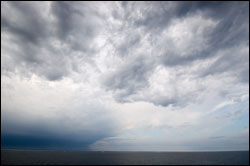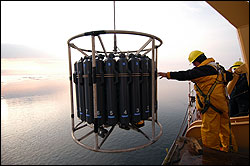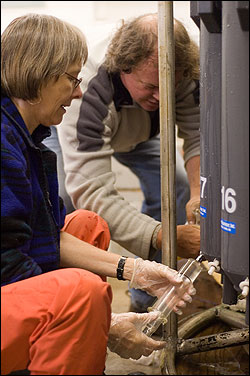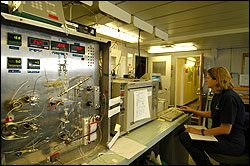Please note: You are viewing
the unstyled version of this website. Either your browser does not support CSS
(cascading style sheets) or it has been disabled. Skip
navigation.
Chris LinderAugust 5, 2005
The CTD watch team has been sampling around the clock as we make our way to the next mooring position. The team is split into two 12-hour watches so that we don't lose any of our precious time up here in the Arctic. As I mentioned in a previous dispatch, the CTD team runs a number of analyses on the water that is retrieved from the icy depths with the Niskin bottles. After the CTD is brought back on deck, it is wheeled into the wet lab so that water samples can be drawn from the bottles. Nes Sutherland and Wendy Richardson arrive on the scene first with a bucket of giant glass syringes. They carefully draw the water from the spigot so that nothing, even the air, contaminates their samples. Then they bring the syringes down to the main lab, where the water is run through a custom-built instrument that can measure the very very tiny concentrations of freons that they are looking for. While many things we measure in arctic waters are naturally occurring substances, such as oxygen or bacteria, there is one that is unique because it is entirely manmade. Freons, also known as chloroflorocarbons (CFCs), used to be important components in refrigeration systems and styrofoam. Mass production was ceased in the 1980s. Why would this be important? How does this relate to oceanography and the Arctic? I sat down with Nes and Wendy in the lab to find out. Wendy explained that "Freons are ideal tracers for oceanography. We know exactly when they were produced, so with that knowledge we can tell when a certain parcel of water was last in contact with the atmosphere. A higher concentration means it was in contact with the atmosphere more recently." Nes added "With a map of these concentrations, you can begin to picture how water masses are moving around, and even whether they came from the Atlantic or Pacific Ocean." If we continue our current speed, tomorrow we will deploy a mooring in the shallow waters just off the Alaskan coast. After placing the mooring we'll be racing north to hunt down our wayward ice buoy. The ship's ice officer, Lucie Theriault, has been tracking the ice floe's movement using detailed satellite images of the ice. She is confident we can locate the buoy. Last updated: October 7, 2019 | ||||||||||||||||||||||
Copyright ©2007 Woods Hole Oceanographic Institution, All Rights Reserved, Privacy Policy. | ||||||||||||||||||||||






